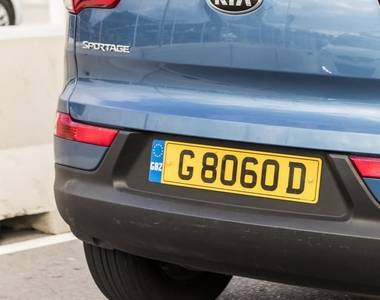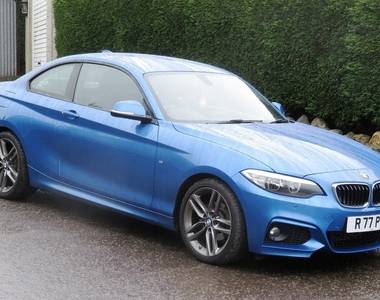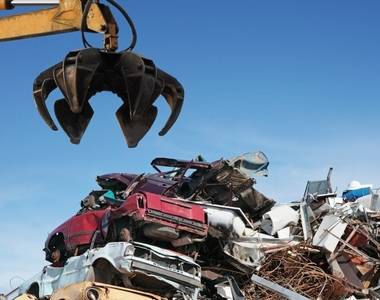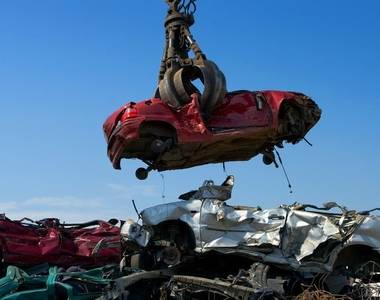It’s easy to take number plates for granted – especially since they often only feel useful to take a shortcut in getting a car insurance quote.
In truth though, vehicle registration plates are an important part of motoring history – both here in the UK, and across most parts of the world. Today, it’s not uncommon for desirable private plates to change hands for tens – or even hundreds – of thousands of pounds. Whilst this phenomena was first established in the United Kingdom, the business of buying and selling numberplates has rapidly expanded to many other parts of the world with Hong Kong and Dubai recording some of the highest value transactions in numberplate history.
Here, we’ll explore the UK number plate in more detail – unravelling where the idea came from, how the systems works, what your vehicle registration plate can tell you, and what the future might hold for how our vehicles are identified.
1903 - The first number plates
One of the first vehicle registration plates issued in the UK was – probably unsurprisingly - ‘A 1’. This plate was issued in early 1904 – and the story goes that Earl Russell, a high-society politician and motor enthusiast, had his butler queue outside council offices overnight to make sure he got this stand-out plate.
While it would make sense that A 1 was the first-ever plate – it’s widely believed that Y 1 and DY 1 pre-dated it. DY 1 is recorded as the first plate ever issued; in Hastings on the 23rd November 1903. As you can imagine, there’s a lot of folklore around the first handful of registration numbers ever to be issued!
Although Great Britain has led the way with many motoring firsts – our European neighbours actually introduced vehicle registration plates before the UK. License plate history shows that France introduced the first number plate in 1893 – and Germany followed in 1896.
Why did we need number plates?
Back in the late 1800s, there were very few vehicles on the roads in the UK – but as we got closer and closer to the 20th Century, cars were becoming more and more popular. Back then, the government started to introduce laws that would help keep roads safe – take for instance the Locomotive on Highways Act of 1896 – the government’s way of making sure people drove on the left side of the road and use lights at night.
Although this handful of rules worked while there were just a few cars on the road, as the new century dawned, 5,000 cars were soon using UK roads - so it became necessary for the authorities to be able to know who each one belonged to at a glance. Parliament convened again and passed the Motor Car Act 1903 – outlining further rules relating to the use and ownership of cars.
With this act – all vehicles needed to be registered with the local council – and the vehicle registration plate was born.
What format did these early number plates follow?
After DY 1 appeared in Hastings and Earl Russell’s butler got his hands on A 1, similar combinations of one or two-letter plus one-number combinations were issued. Logically A 2 followed A 1 and so on, and depending on the density of cars being registered for use on British highways the initial registration series theoretically ran all the way to A 9999.
The early years of the 20th Century were a fast-moving time for the motoring world. Cars were becoming more and more popular, and the use of vehicles for moving and delivering goods was becoming increasingly popular too. To keep up with demand, a new registration process was introduced – and different local councils were authorised to complete the registration process, each being given their own characters to issue to local vehicles. The issuing office was called a vehicle registration office, often shortened to the acronym VRO.
1920 - Local registrations for local councils
The Roads Act of 1920 saw that different areas around the UK were expanded and specifically given different letter prefixes for their cars’ number plates. London council offices stuck with the letter A, Lancashire was given the letter B – and West Yorkshire took C.
With ‘less major’ regions and towns (In terms of vehicle registration density) being given two-letter combinations. Cardiff was given HB, Leeds got WR, and PR was issued in Brighton. As areas expanded, so too did the range of letter combinations – helping to keep up with the surge in popularity of motoring.
Understandably, number plate combinations in different areas ran out at different times. For instance, the Isle of Bute (which today still has less than 7,000 residents) could keep up with demand far easier than a busy London borough. As a result their first combination SJ 1 was followed by a short series of SJ numberplates followed by numbers. Notably, many of the higher number combinations and the reversals were never issued by the original authority. Subsequently, we see the SJ range and many other two letter initials from similarly low population areas, being issued by DVLA auctions in more recent years; examples being 1 SJ, Sold in December 1992; 2 SJ, Sold in October 1994 and 3 SJ, Sold in May 2013. We can briefly consider how dateless numberplate valuations and appraisals are generated with the knowledge gained so far. Logically speaking, there is a greater appeal for the vehicle registration number SJ 1, considering it was issued shortly after the turn of the 20th century in 1904 and has survived over a century, being maintained on cars being used on British highways. By comparison, the registration 1 SJ was acquired for £15,000 on the hammer, after being issued at auction in 1992 and whilst it’s an extremely desirable cherished registration, it has a significantly less appeal, and therefore value, than the ‘antique’ SJ 1.
1950+ - Keeping up with the motoring boom
Car ownership figures exploded between 1950 and 1970. In 1950, there were around 4 million vehicles on the road – but by 1970, that number had grown to 13.5 million. As greater numbers of cars hit UK roads and in some areas the single and double letter combinations simply run out! The government motoring infrastructure had to grow and so the format of dateless registrations changed again; with the introduction of an extra letter and one less number; subsequently the range started with AAA 1 all the way to AAA 999 and then as above was reversed if demand exceeded the number of combinations available in any given area.
The old system of ‘dateless’ number plate was finally overhauled in 1963, and a new format was introduced – the ‘suffix plate’. It is noteworthy to reiterate that irrespective of whether or not a local area had totally issued all of the dateless registration plates, they were forced to adopt the new Suffix style. The DVLA did not know it at the time, but this was to become one of the biggest windfalls for British government, delivering hundreds of millions of pounds worth of revenue for the British government as they introduced their Auctions in December 1989 and started to sell previously unissued registrations.
1963 - The suffix plate
In 1963, it was decided that a new format for number plates would be used – and this time, more information could be included.
Enter the ‘suffix plate’.
The suffix (end) part of the vehicle registration mark was especially important because it showed the year that the vehicle was registered. Since this almost always corresponded with the year of manufacturer, you could tell the age of a vehicle with just a quick glance. So; vehicles registered in 1963 would have a Suffix letter of A – and this continued until 1983, with the final letter Y. It was decided that the letters I, O, Q, U, and Z would be left out – as they could be too easily mistaken for similar-looking numbers or letters. Ironically, letter and number confusion is a feature that has generated some of the most desirable and valuable numberplates transacted in the last 30 years, examples such as CLA 55, K1 NKY and SAT 4N; today owned by the church of Satan.
Like the ‘dateless’ plates they replaced, suffix plates included regional identifiers built-in to the first three letters of the combination.
1965 - The introduction of the DVLC and DVLA
Today, virtually all drivers have heard of the Driver and Vehicle Licensing Agency (DVLA) – not least because it’s who road tax is paid to – but the DVLA’s roots are very much tied to number plates and vehicle registrations.
Back in 1965, it was decided that number plate allocation had become too large a task for local council offices to carry out – so a dedicated licensing centre was set up. Back then, it was called the Driver and Vehicle Licensing Centre (DVLC) – and like today, it was based in Swansea.
The DVLC kept records of all car registrations and their respective owners. As car numbers on UK roads have grown, this has become an absolutely invaluable way of tracking the cars and owners – helping to prevent crime and keep tabs on vehicle safety.
Today, the DVLA is responsible for a huge number of vehicle and driver-related tasks and records. As part of the Department for Transport, the DVLA creates and maintains vehicle records, issues registration certificates, collects vehicle excise duty (VED), and it tracks ownership, accident, scrapping, and theft details.
The DVLA has become known as the go-to place for everything car or driver related – but in truth, the DVSA (Driver and Vehicle Standards Agency) actually covers a similar number of tasks. DVLC, DVLA and DVSA are often mixed up, but the DVSA carry out driving tests, approve people to be driving instructors and MOT testers, carry out tests to make sure lorries and buses are safe to drive, carry out roadside checks on drivers and vehicles, and monitor vehicle recalls. The DVSA is the official executive agency, sponsored by the Department for Transport.
1983 - Prefix plates
Due to the fact that the last letter of the suffix registration number denoted the year of issue, regardless of how many registrations had been carried out, each year a whole new series of suffix registrations were issued. And ultimately, as suffix plates came to the end of the alphabet, the DVLC decided the easiest way to continue issuing vehicle registrations would be to simply reverse the format.
With that, the ‘prefix plate’ was created.
From August 1983, the letter used to indicate the age of the vehicle would appear at the start of the registration – followed by one to three numbers – followed by a three-letter sequence. Like suffix plates, the letters I, O, Q, U, and Z would be left out to avoid potential confusion.
Again, a regional identifier was included in the final three letters of the plate. By this time however the ‘penny had dropped’ with the DVLA that shorter combinations were often more desirable than seven character combinations and therefore could generate revenue for the Treasury. Subsequently, the numbers A1 through to A20 were withheld for what would become the Select Registrations scheme offered by DVLA. The range 1 to 20 was expanded significantly as the years progressed, with many more desirable number ranges such as 10, 20, 30, 22 and all triple numbers like 888 and 999 being withheld for sale.
This format ran until March 2001 – when the letter Y was issued, and no further letters were available to keep generating registration marks.
2001 - Current style plates
In March 2001, current style plates were introduced. Here, it was decided that a complete redesign of the vehicle registration mark would take place. Although there was significant format change, there was also pressure from the motor industry for the government to change registration marks more frequently.
Why?
Well, it was all down to new car sales. Since customers were keen to have the most up-to-date number plate as possible, new car sales had become heavily weighted towards the end of August new plate release date. As such, the DVLA began issuing two new registration marks each year – one in March and one in September.
As well as being able to support two age changes each year, the new plate format had to also:
• Fit the existing number plate dimensions (having seven characters or fewer)
• Make it easy to identify the age of the vehicle
• Be easy to remember and easy to read
With this in mind, the following format was decided on:
• Two letters (often called the ‘memory tag’ – showing the location of issue)
• Two numbers (showing the age of the vehicle)
• Three letters (not including either I or Q)
Registrations that are issued between March and August show an age code that corresponds to the year. For example, a 2018 car will show ‘18’. However, vehicles that are registered between September to February show the year code with 50 added to it. For example, a 2018 car would show the age identifier ‘68’.
This current format has enough unique combinations to run until the year 2050.
How the DVLA has evolved
From its introduction in 1965, right through to the present day, the DVLA has moved with the times. In 2004, the DVLA introduced Electronic Vehicle Licencing (EVL) – an innovative system that allowed customers to pay their VED online or over the phone.
While the motoring boom of the 60s and 70s led to a network of 39 regional Vehicle Registration Offices opening around the UK, the age of the internet led to a declining need for staffed premises. In 2013, these regional offices closed – and the operation was once again run entirely from the organisation’s Swansea head office.
Today, the DVLA continues to adjust to the changing requirements of our interconnected, online world. For a long time, it’s been normal to shop for car insurance online - and now, many of the official DVLA tasks that previously required a visit to the Post Office to carry out can now be done online too – including taxing your car. What’s more, to help combat increasingly sophisticated fraudsters, the DVLA now include a ‘validation character’ on V5C log book documents – another layer of security to protect people who are buying pre-owned vehicles against fraud and forgeries.
Personalised number plates
He might not have realised it, but in 1903, Earl Russell trying to get his hands on ‘A 1’ laid the foundations for a trend that would still be popular nearly 120 years later.
Today, your number plate can say more about you than the car you drive.
Personalised number plates go by a variety of different names, so depending on where you’re from, you might refer to one as a ‘vanity plate’, a ‘prestige plate’, a ‘custom plate’, or a ‘cherished plate’. Whatever you call them, one’s things for sure; private plates are big business – and the most exclusive personalised plates can be worth far more than most of the cars on the road.
Cherished number dealers
The official DVLA term for a personalised registration dealer is a ‘cherished number dealer’ – and tens of thousands of these private plates change hands every year through these official suppliers.
The trade of personalised plates is such big business that there are two trade bodies. As such, a dealer can become a Member of the Institute of Registration Agents and Dealers (MIRAD) and/or become part of the RMI Cherished Numbers Dealers Association (CNDA).
We’ve been in the cherished number plate business for almost as long as the trade bodies have been established – working as a part of businesses that started trading personalised plates as far back as 1989. In fact, it was our company that first used the Internet to sell car registrations way back in 1996 under the URLs Registrations.com and NewReg.com, paving the way for the DVLA and every other purveyor of private registrations. Today, we use Car.co.uk to continue to bring our clients a wealth of experience and also the cheapest possible price to buy a DVLA number plate, often cheaper than the issue price by the DVLA registrations themselves. We do this by offering a range of other services and generating a very loyal client base through the high-quality service we deliver.
Number plates as investments
As well as being an interesting way to add a splash of personality to your vehicle, a private reg may also be an incredible investment opportunity. In fact, it’s not uncommon for a cherished number plate to increase in value – while the car it’s on depreciates!
Take the plate ‘F1’, for example. Back in January 2008, the plate was bought for less than £400,000. Fast forward ten years and the plate was for sale again – with an asking price of over £1 million. Now, that’s the kind of investment that only a Formula 1 driver might be able to make now – but with new registrations being launched by the DVLA all the time, much lower price registrations still have the chance to increase significantly.
How number plate materials have changed
You won’t be surprised to discover that the reflective plastic plates that we see today are fairly new number plate innovation.
Back in 1903, number plates were thin plate metal – usually black with white, grey, or silver characters painted on or pressed into the sheet.
Metal plates began to be phased out in 1967 though – with ‘retroreflective’ plates becoming the accepted standard. This new style of plate was created to meet British Standard BS AU 145 – created to make sure number plates were safe and long-lasting.
Since then, plate standards have developed – with the most recent BS AU 145d still effective today. More recently standards improvements mean plates last longer and are more resistant to impacts and bending – and forthcoming standards (BS AU 145e), published online at the BNMA, will mean that future number plates stand up to even more weathering, wear, and abrasion than ever before.
Number plates can only be made by registered number plate suppliers – and they require the buyer to prove ownership of the vehicle that the plate will be used on.
The future of number plates
Vehicles have changed beyond all recognition since the first number plate was issued back in 1903. Today, the internal combustion engine is being phased out – and we’re ushering in a new era of electric vehicles.
While onboard CPUs and computer engine-management in vehicles are nothing new – the coming generation of cars will be more connected than ever before. In fact, it’s reasonable to assume a permanent connection to the internet will be likely. In a world where our mobile phones can recognise our faces and can predict the next journey we’re going to make – it’s questionable how important a plastic number plate and seven-digit registration mark will be.
So, what could replace number plates? QR codes? A computer networking IP/MAC address? Perhaps our cars will simply sync with our mobile devices?
Whatever the future holds for vehicle ownersship and tech, there are a lot of drivers that are very attached to their personalised number plates – so even if our vehicles become as connected as our phones, we can expect to see private plates hanging around for a long time to come.











